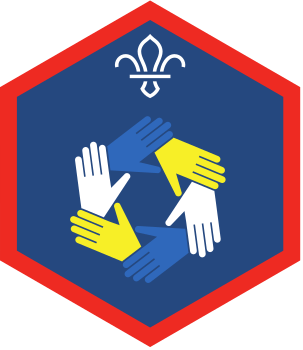Private mobile radio
What to expect
Private mobile radio uses the radio technology we’ve all seen on TV and become familiar with, although not everyone has actually used this kind of two-way radio. A common example of a two-way radio is a walkie-talkie, which some might’ve used before. Professional-grade private mobile radios are often used by organisers at events to keep in touch, or by security guards and the police. Walkie-talkies don’t require a licence and private mobile radio do. For this reason, many different organisations, including Scouts, have a licence for their use.
The advantage of private mobile radios is that they allow for closed (private) communications over a distance, something which can be useful at camp when playing wide games or planning activities. It’s also an activity in its own right and can be particularly useful if you’re hiking in areas with poor mobile phone reception.
An example of an activity that relies on private mobile radio might be if your group splits in half with a radio each. One half has a map and has to communicate with the other half so that they can navigate. Not only would this use communication skills, but it also draws on other important skills like map reading. Radios can also be used to supplement other activities, particularly organisations tasks, like running gang shows or activities for the Communicator Activity Badges.
What you’ll learn
Using private mobile radios is an interesting way to develop communication skills and try something that your group might not have done before. They can add a spin to activities and events, and show how keeping in touch over a distance can make life easier or more productive.
This activity can also help develop a range of technical skills and introduce equipment that people may rely on later in work or training. Not only can your group become competent radio users, they can also gain the skills needed to organise events and stay in touch with a team while planning.
Fun facts
The first mobile private radio was developed in 1923 in Australia by the Victoria Police, though it wasn’t very mobile, as it took up the entire back seat of a car. It was however very useful, as it allowed police to communicate directly with the station, rather than phoning the station up from a public phone box to report what they’d found. Walkie-talkies came into use during WW2 to help coordinate troops.
Handy hints
- Keep in touch with the comms team. Some regions, counties or districts may have set up a communications team. If so, it’s possible that they have the equipment for this activity and may be willing to lend it to groups in return for a donation. The equipment could also be purchased to be shared between groups. Things that need to be priced in include the private mobile radio sets, battery chargers, spare batteries and the annual licence fee.
- Not so private. It’s helpful to note that whilst they are referred to as ‘private radios’, private mobile radio frequencies are in fact open and anyone can listen to what’s being said. Best to agree on a secret code beforehand, so that you can identify who’s talking!
Safety
You must always:
- Complete a risk assessment
- Have the right ratios of number of adults to provide suitable supervision
- Set up an InTouch process
- Know what to do in an emergency
- Share information with parents and carers with an activity information form
- Get approval from your commissioner
PMR:
xxx
Other activities:
- Where an activity is not covered by any other rules members must follow rule 9.1 and assess the risk, ensure that members can be kept safe and that all equipment is suitable for its use.
This activity can be led by you or someone else in Scouts
You can go to a centre or use an activity leader who is not part of Scouting:
You must find a suitable provider who meets the following requirements:The provider must have public liability insurance.
Guidance
Reflection
This activity helped you communicate in a way that you might not have tried before. Take a moment to think about the difficulties and advantages of using private mobile radio. What was different about talking over the radio than talking in person? When we talk face to face, a lot of communication happens through body language, which is impossible with mobile radio. What advantages are there to having radio? Being able to communicate at a distance makes it easier to organise and see what’s happening in other places. This activity also helped you develop skills that can help you become a professional in the world of radio communications.
What other types of radio communications might you want to try after this? The activities in the Communicator Activity Badge offer a number of ideas that you can try in amateur radio. With something like a USB software-defined radio interface, a person could listen to anything from music to ham radio frequencies.
Private mobile radios allow communication between people who aren’t necessarily in the same room, at different parts of a large camp or even in different locations entirely. It may be an idea to practise their use in games first, so that your group can get used to communicating with someone who isn’t directly in front of them, in situations where they can’t necessarily see the same things as the speaker.
- Private mobile radio activities can often be adapted so more people can give it a go. Many centres have facilities that cater for people with additional needs and experienced instructors to help everyone achieve their goals. Get in touch with your local provider to chat through the needs of people in your group. Make sure you give them plenty of notice.
- Private mobile radios can be used by many, particularly with accessibility equipment. Get in touch with your communications team if you have one, to chat through the needs of people in your group – make sure to do this in advance in case adjustments take time to arrange. In some circumstances, group members with hearing impairments may be able to use an audio induction loop with a compatible handset.
All Scout activities should be inclusive and accessible.
Private mobile radios can be used to extend a variety of activities. They can be taken on camp so that different groups can keep in touch with each other and meet up easily. They can be used to help plan and coordinate events such as a performance for the Musician Staged Activity Badge or a gallery for the Beavers Creative Activity Badge, or Cubs or Scouts Artist Activity Badge. The Beavers, Cubs and Scouts Communicator Activity Badge contains a number of activities related to radio and communications that can follow on from handheld radio use.
Some amount of leader instruction may be needed when using these radios for the first time, although there’s no reason that people in your group cannot show each other how to use the equipment once they’ve got the hang of it. In many of the activities that require organisation or event preparation, your group will likely be in charge of the planning and execution of the event, so private mobile radio use during these activities may encourage your group to find the most efficient ways of using the equipment.



